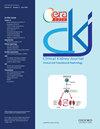综合多种肾功能指标预测全因和心血管疾病死亡率:对 366 758 名英国生物库参与者的前瞻性分析
IF 3.9
2区 医学
Q1 UROLOGY & NEPHROLOGY
引用次数: 0
摘要
背景 & 假设 肾功能减退是心血管和全因死亡率的一个风险因素。几种肾功能标志物都证明了这种关联,但目前还不清楚整合多种测量标志物是否能改善死亡率风险预测。方法 我们对英国生物库中 366 758 名无肾衰竭病史的参与者进行了探索性因子分析(EFA),分析了基于血清肌酐和胱抑素 C 的估计肾小球滤过率(eGFRcre 和 eGFRcys,由慢性肾脏病流行病学协作组(CKD-EPI)和欧洲肾功能联盟(EKFC)公式得出)、血尿素氮(BUN)、尿酸和血清白蛋白。通过拟合 Cox 比例危险模型,我们比较了已确定的潜在因素预测总死亡率和心血管疾病(CVD)死亡率的能力,同时还考虑了冠心病和脑血管疾病等心血管疾病的特异性病因。结果 在 12.5 年的随访中,26 327 人死于任何原因,5 376 人死于心血管疾病,2 908 人死于冠心病,1 116 人死于脑血管疾病。我们发现了两个潜在因素,即 EFA1 和 EFA2,它们都代表肾功能的变化。在使用 CKD-EPI 方程时,EFA1 的表现与 eGFRcys 相似,但 EFA1 对总体死亡率和心血管疾病相关死亡率的危险比稍高。在 10 年的随访中,EFA1 和 eGFRcys 对心血管疾病相关死亡率显示出中等程度的鉴别性能,优于所有其他肾脏指数。在使用 EKFC 方程时,eGFRcys 的表现优于 EFA1,而所有其他结果均相似。结论 虽然 EFA 是捕捉肾功能复杂效应的一种有吸引力的方法,但 eGFRcys 仍是预测全因和心血管疾病死亡风险的最实用、最有效的测量方法。本文章由计算机程序翻译,如有差异,请以英文原文为准。
Integrating multiple kidney function markers to predict all-cause and cardiovascular disease mortality: prospective analysis of 366,758 UK Biobank participants
Background & Hypothesis Reduced kidney function is a risk factor of cardiovascular and all-cause mortality. This association was demonstrated for several kidney function markers, but it is unclear whether integrating multiple measured markers may improve mortality risk prediction. Methods We conducted an exploratory factor analysis (EFA) of serum creatinine- and cystatin C-based estimated glomerular filtration rate (eGFRcre and eGFRcys, derived by Chronic Kidney Disease Epidemiology Collaboration (CKD-EPI) and European Kidney Function Consortium (EKFC) equations), blood urea nitrogen (BUN), uric acid, and serum albumin among 366 758 participants of the UK Biobank without history of kidney failure. Fitting Cox-proportional hazard models, we compared ability of the identified latent factors to predict overall mortality and mortality by cardiovascular disease (CVD), also considering CVD-specific causes like coronary heart disease and cerebrovascular disease. Results During 12.5 years of follow-up, 26 327 deceased from any cause, 5 376 died from CVD, 2 908 from CHD, and 1 116 from cerebrovascular disease. We identified two latent factors, EFA1 and EFA2 both representing kidney function variations. When using the CKD-EPI equations, EFA1 performed like eGFRcys, with EFA1 showing slightly larger hazard ratios for overall and CVD-related mortality. At 10-years of follow-up, EFA1 and eGFRcys showed moderate discrimination performance for CVD-related mortality, outperforming all other kidney indices. eGFRcre was the least predictive marker across all outcomes. When using the EKFC equations, eGFRcys performed better than EFA1, all other results remaining similar. Conclusions While EFA is an attractive approach to capture the complex effects of kidney function, eGFRcys remains the most practical and effective measurement for all-cause and CVD mortality risk prediction.
求助全文
通过发布文献求助,成功后即可免费获取论文全文。
去求助
来源期刊

Clinical Kidney Journal
Medicine-Transplantation
CiteScore
6.70
自引率
10.90%
发文量
242
审稿时长
8 weeks
期刊介绍:
About the Journal
Clinical Kidney Journal: Clinical and Translational Nephrology (ckj), an official journal of the ERA-EDTA (European Renal Association-European Dialysis and Transplant Association), is a fully open access, online only journal publishing bimonthly. The journal is an essential educational and training resource integrating clinical, translational and educational research into clinical practice. ckj aims to contribute to a translational research culture among nephrologists and kidney pathologists that helps close the gap between basic researchers and practicing clinicians and promote sorely needed innovation in the Nephrology field. All research articles in this journal have undergone peer review.
 求助内容:
求助内容: 应助结果提醒方式:
应助结果提醒方式:


